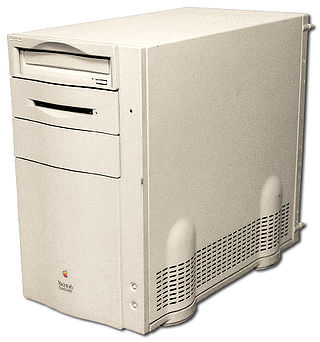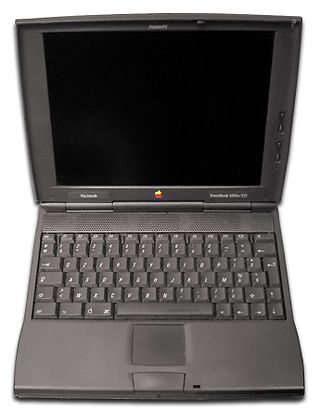
The Power Macintosh G3 is a series of personal computers designed, manufactured, and sold by Apple Computer from November 1997 to August 1999. It represented Apple's first step towards eliminating redundancy and complexity in the product line by replacing eight Power Macintosh models with three: Desktop and Mini Tower models for professional and home use, and an all-in-one model for education. The introduction of the Desktop and Mini Tower models coincided with Apple starting to sell build-to-order Macs directly from its web site in an online store, which was unusual for the time as Dell was the only major computer manufacturer doing this. Apple's move to build-to-order sales of the Power Macintosh G3 also coincided with the acquisition of Power Computing Corporation, which had been providing telephone sales of Macintosh clones for more than two years.

The Power Mac G4 is a series of personal computers designed, manufactured, and sold by Apple Computer from 1999 to 2004 as part of the Power Macintosh line. Built around the PowerPC G4 series of microprocessors, the Power Mac G4 was marketed by Apple as the first "personal supercomputers", reaching speeds of 4 to 20 gigaFLOPS. This was the first existing Macintosh product to be officially shortened as "Mac", and is the last Mac able to boot into classic Mac OS.

The Macintosh Classic II is a personal computer designed and manufactured by Apple Computer, Inc. from October 1991 to September 1993. The system has a compact, appliance design with an integrated 9" monitor, typical of the earliest of the Macintosh range. A carrying handle moulded into the case added a degree of portability at a time when laptops were still relatively uncommon.

The Macintosh IIvx is a personal computer designed, manufactured and sold by Apple Computer from October 1992 to October 1993. It is the last of the Macintosh II family of Macintosh computers. The IIvx was introduced at the same time as the Macintosh IIvi, with both models using the same metal case design as the earlier Performa 600 and Performa 600CD. Like the Performa 600CD, the IIvx could be equipped with an internal double-speed CD-ROM drive.

The Macintosh Quadra 950 is a personal computer designed, manufactured and sold by Apple Computer from March 1992 to October 1995. It replaced the Quadra 900 that was introduced several months earlier, increasing the CPU clock rate of its 68040 CPU from 25 MHz to 33 MHz, and improving the graphics support. The two computers were otherwise identical, including the price. With a Macintosh Processor Upgrade Card installed, this computer is known as the Power Macintosh 950.

The Power Macintosh 6100 is a personal computer designed, manufactured and sold by Apple Computer from March 1994 to March 1996. It is the first computer from Apple to use the new PowerPC processor created by IBM and Motorola. The low-profile ("pizza-box") case was inherited from the Centris/Quadra 610 and 660AV models, and replaced the Macintosh Quadra series that used the Motorola 68040 processor, Apple's previous high-end workstation line.

The Power Macintosh 7500 is a personal computer designed, manufactured and sold by Apple Computer from August 1995 to May 1996. The 7500 was introduced alongside the Power Macintosh 7200 and 8500 at the 1995 MacWorld Expo in Boston. Apple referred to these machines collectively as the "Power Surge" line, communicating that these machines offered a significant speed improvement over its predecessors. The 7500 introduced a new case design, later dubbed "Outrigger" by Mac enthusiasts. There were two derivative models: the Power Macintosh 7600, identical to the 7500 except for the CPU which was a PowerPC 604 or 604e processor instead of the 7500's 601; and the Power Macintosh 7300, identical to the 7600 but without the video inputs found in both the 7500 and 7600.

The Macintosh Quadra 605 is a personal computer designed, manufactured, and sold by Apple Computer from October 1993 to July 1996. The model names reflect a decision made at Apple in 1993 to follow an emerging industry trend of naming product families for their target customers – Quadra for business, LC for education, and Performa for home. Accordingly, the Performa 475 and 476 was sold in department stores and electronics stores such as Circuit City, whereas the Quadra was purchased through an authorized Apple reseller.

The Power Macintosh 9500 is a personal computer designed, manufactured and sold by Apple Computer from June 1995 to February 1997. It is powered by a PowerPC 604 processor, a second-generation PowerPC chip which is faster than the PowerPC 601 chip used in the Power Macintosh 8100. The 180MP and 200 MHz models, introduced August 1996, use the enhanced PowerPC 604e processor.

The Macintosh Quadra 800 is a personal computer that is a part of Apple Computer's Quadra series of Macintosh computers.

The Power Macintosh 6200 is a series of personal computers designed, manufactured, and sold by Apple Computer from May 1995 to July 1997. The 6200 is the PowerPC-based replacement for the Quadra 630, with the same form factor and price range. In early 1997, the rather different Power Macintosh 6300/160 / Performa 6360 based on the Power Macintosh 6400 was introduced. The whole line was discontinued when the desktop model of the Power Macintosh G3 was released.

The Macintosh Quadra 630 is a personal computer designed, manufactured and sold by Apple Computer from July 1994 to October 1995. It was introduced as the replacement for the Quadra 610, and was the least-expensive computer in the Macintosh lineup with prices starting at $1,199 USD.

The Macintosh Quadra 650, originally sold as the Macintosh Centris 650, is a personal computer designed, manufactured and sold by Apple Computer from February 1993 to September 1994. The Centris 650 was introduced alongside the smaller Centris 610 as the replacement for the Macintosh IIci and Quadra 700, and it was intended as the start of the new midrange Centris line of computers. Later in 1993, Apple decided to follow an emerging industry trend of naming product families for their target customers – Quadra for business, LC for education, and Performa for home – and folded the Centris 650 into the Quadra family.
The Macintosh LC 500 series is a series of personal computers that were a part of Apple Computer's Macintosh LC family of Macintosh computers, designed as a successor to the compact Macintosh family of computers for the mid-1990s mainstream education-market. The all-in-one desktop case is similar to the then recently introduced Macintosh Color Classic, but the LC 500 series is considerably larger and heavier due to its larger screen and a bulging midsection to house the larger electronics, including a 14" CRT display, CD-ROM drive, and stereo speakers.

The PowerBook 1400 is a notebook computer that was designed and sold by Apple Computer, Inc. from 1996 to 1998 as part of their PowerBook series of Macintosh computers. Introduced in October 1996 at a starting price of $2,499, it was the first new PowerBook after the controversial PowerBook 5300. After the introduction of the more powerful PowerBook 3400c in February 1997, the 1400 took on the role of Apple's entry level notebook and remained there until its discontinuation in May 1998. Its successor, the PowerBook G3 Series, would ultimately go on to replace and consolidate not only the 1400, but the 2400c and 3400c as well.

The Power Macintosh 6500 is a personal computer designed, manufactured and sold by Apple Computer from February 1997 to March 1998 as part of the Power Macintosh family. It was introduced with speeds of 225 and 250 MHz, with two faster models at 275 and 300 MHz being added a couple of months later.

The Power Macintosh 5260 is a personal computer designed, manufactured and sold by Apple Computer, Inc. from April 1996 to March 1997. It is a replacement for the Power Macintosh 5200 LC, retaining its all-in-one form factor while replacing its PowerPC 603 CPU with the newer and faster PowerPC 603e, and dropping the "LC" brand. As was standard practice at the time for Apple, the 5260 was re-branded as a number of Performa models and sold to consumer markets, while the 5260 itself was primarily sold to the North American education market as a Power Macintosh.

The Compaq Presario 1200 was a line of notebook computers produced between 1998 and 2000 by Compaq as part of Compaq Presario line.
The Power Macintosh 5400 is a personal computer designed, manufactured and sold by Apple Computer from April 1996 to March 1998. The 5400 is an all-in-one computer with an integrated monitor, and replaced the Power Macintosh 5200 LC in that role. It is largely identical to the Power Macintosh 6400 internally, which is essentially the same computer in a tower case. This is the first all-in-one Macintosh to support PCI expansion, replacing the Processor Direct Slot.

The Power Macintosh 6400 is a personal computer designed, manufactured and sold by Apple Computer from August 1996 to August 1997. It is the only Macintosh mini-tower system to be branded as a Performa, and alongside the Performa 6360 was the last new Performa-branded model introduced by Apple.



















